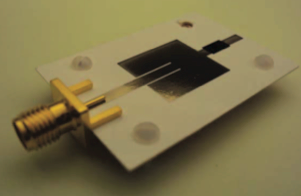Georgia Tech inventors have developed highly sensitive gas sensors utilizing carbon nanotubes integrated with antennas and electronics that enable wireless remote detection. The CNTs can be modified to provide or increase sensitivity to a particular chemical species. The low cost fabrication process consists of printing conductive ink to form a transmission line in contact with the antenna element, followed by the application of CNTs at its edges. This technique can be applied to a variety of substrates such as paper or polymer films. The sensors’ antenna can consist of a patch antenna, multiple radiating elements or other antenna configuration in communication with a CNT sensor element. These antenna-based CNT sensors respond to the presence of chemical species with a change in resonant frequency.
- Extremely sensitive gas sensor based on the change in resonant frequency of circuit caused by interaction of gas molecules with carbon nanotubes
- CNTs can be functionalized to detect one or more analytes with high specificity
- Sensor can be manufactured using inkjet printing technologies to reduce costs
- Integration of an efficient antenna in the sensor enables wireless transmission for standoff detection applications
- Environmental
- Industrial
- Defense
- Security
- Toxic gas detection systems
- Drugs, explosives and chemical weapons monitoring
Carbon nanotubes (CNTs) have great potential as materials for the development of portable sensors. They have a small size, light weight, excellent electrical conductivity, and can be functionalized for enhanced or selective surface adsorption of a wide range of chemicals. Several studies confirm chemical detection based on either a shift in resonant frequency or change in amplitude caused by the interaction of CNTs with absorbed molecules. However, the use of CNT remotely operated sensors has been limited by low signal to noise, efficient manufacturing processes and power requirements for wireless operation.

